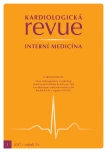Cardiotoxicity – basic terms and mechanisms
Authors:
R. Pudil
Authors‘ workplace:
I. interní kardioangiologická klinika LF UK a FN Hradec Králové
Published in:
Kardiol Rev Int Med 2017, 19(1): 7-10
Overview
Cardiotoxicity represents a very serious adverse effect of anti-tumour therapy. Cardiotoxicity includes a broad spectrum of symptoms: myocardial dysfunction and heart failure, coronary artery disease, valvular disease, arrhythmias (especially those induced by QT-prolonging drugs), arterial hypertension, thromboembolic disease, peripheral vascular disease and stroke, pulmonary hypertension and pericardial complications. The paper discusses the basic terms, mechanisms and diagnostic procedures for the detection of cardiotoxicity (ECG, echocardiography, CMR, biomarkers).
Keywords:
cardiotoxicity – heart failure – arrhythmias – electrocardiogram – echocardiography – cardiac markers
Sources
1. Zamorano JL, Lancellotti P, Rodriguez Muñoz D et al. 2016 ESC Position Paper on cancer treatments and cardiovascular toxicity developed under the auspices of the ESC Committee for Practice Guidelines. Eur Heart J 2016; 37(36): 2768 – 2801.
2. Bloom MW, Hamo CE, Cardinale D et al. Cancer therapy-related cardiac dysfunction and heart failure: Part 1: definitions, pathophysiology, risk factors, and imaging. Circ Heart Fail 2016; 9(1): e002661. doi: 10.1161/ CIRCHEARTFAILURE.115.002661.
3. Tewey KM, Rowe TC, Yang L et al. Adriamycin-induced DNA damage mediated by mammalian DNA topoisomerase II. Science 1984; 226(4673): 466 – 468.
4. Vejpongsa P, Yeh ET. Topoisomerase 2beta: a promising molecular target for primary prevention of anthracycline-induced cardiotoxicity. Clin Pharmacol Ther 2014; 95(1): 45 – 52. doi: 10.1038/ clpt.2013.201.
5. Gershwin ME, Goetzl EJ, Steinberg AD. Cyclophosphamide: use in practice. Ann Intern Med 1974; 80(4): 531 – 540.
6. Braverman AC, Antin JH, Plappert MT et al. Cyclophosphamide cardiotoxicity in bone marrow transplantation: a prospective evaluation of new dosing regimens. J Clin Oncol 1991; 9(7): 1215 – 1223.
7. Quezado ZM, Wilson WH, Cunnion RE et al. High-dose ifosfamide is associated with severe, reversible cardiac dysfunction. Ann Intern Med 1993; 118(1): 31 – 36.
8. Field JJ, Kanakkanthara A, Miller JH. Microtubule-targeting agents are clinically successful due to both mitotic and interphase impairment of microtubule function. Bioorg Med Chemi 2014; 22(18): 5050 – 5059. doi: 10.1016/ j.bmc.2014.02.035.
9. Giordano SH, Booser DJ, Murray JL et al. A detailed evaluation of cardiac toxicity: a phase II study of doxorubicin and one - or three-hour-infusion paclitaxel in patients with metastatic breast cancer. Clin Cancer Res 2002; 8(11): 3360 – 3368.
10. Pritchard KI, Shepherd LE, O'Malley FP et al. HER2 and responsiveness of breast cancer to adjuvant chemotherapy. N Engl J Med 2006; 354(20): 2103 – 2111.
11. Piccart-Gebhart MJ, Procter M, Leyland-Jones Bet al. Trastuzumab after adjuvant chemotherapy in HER2-positive breast cancer. N Eng J Med 2005; 353(16): 1659 – 1672.
12. Krop IE, Suter TM, Dang CT et al. Feasibility and cardiac safety of trastuzumab emtansine after anthracyclinebased chemotherapy as (neo)adjuvant therapy for human epidermal growth factor receptor 2positive early-stage breast cancer. J Clin Oncol 2015; 33(10): 1136 – 1142. doi: 10.1200/ JCO.2014.58.7782.
13. Ferrara N. Role of vascular endothelial growth factor in regulation of physiological angiogenesis. Am J Physiol Cell Physiol 2001; 280(6): 1358 – 1366.
14. Pudil R, Horacek JM, Horackova J et al. Anthracycline therapy can induce very early increase in QT dispersion and QTc prolongation. Leuk Res 2008; 32(6): 998 – 999.
15. Dorup I, Levitt G, Sullivan I et al. Prospective longitudinal assessment of late anthracycline cardiotoxicity after childhood cancer: the role of diastolic function. Heart 2004; 90(10): 1214 – 1216.
16. Pudil R, Horacek JM, Strasova A et al. Monitoring of the very early changes of left ventricular diastolic function with acute leucemia treated with anthracyclines. Exp Oncol 2008; 30(2): 160 – 162.
17. Cardinale D, Sandri MT, Colombo A et al. Prognostic value of troponin I in cardiac risk stratification of cancer patients undergoing high-dose chemotherapy. Circulation 2004; 109(22): 2749 – 2754.
18. Cardinale D, Sandri MT, Martinoni A et al. Left ventricular dysfunction predicted by early troponin I release after high-dose chemotherapy. J Am Coll Cardiol 2000; 36(2): 517 – 522.
19. Horacek JM, Pudil R, Jebavy L et al. Assessment of anthracycline induced cardiotoxicity with biochemical markers. Exp Oncol 2007; 29(4): 309 – 313.
20. Kongbundansuk S, Hundley WG. Noninvasive imaging of cardiovascular injury related to the treatment of cancer. JACC Cardiovasc Imaging 2014; 7(8): 824 – 838. doi: 10.1016/ j.jcmg.2014.06.007.
21. Yeh ET, Vejpongsa P. Subclinical cardiotoxicity associated with cancer therapy: early detection and future directions. J Am Coll Cardiol 2015; 65(23): 2523 – 2525. doi: 10.1016/ j.jacc.2015.04.012.
Labels
Paediatric cardiology Internal medicine Cardiac surgery CardiologyArticle was published in
Cardiology Review

2017 Issue 1
Most read in this issue
- Diuretics and mineralocorticoid receptor antagonists in the therapy of chronic heart failure with reduced left ventricular ejection fraction
- COSYREL – a drug for patients with coronary artery disease and heart failure
- Rivaroxaban – pharmacological profile
- Late consequences of cardiotoxicity
